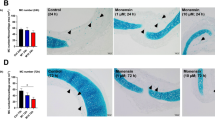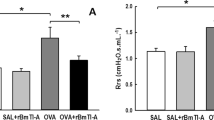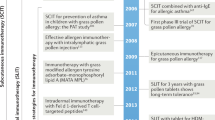Abstract
EXPOSURE of isolated sensitised guinea pig or human airway tissue to specific antigen produces a rapid and prolonged contraction which has been studied as a model of asthmatic bronchospasm. This response is thought to be mediated by endogenous chemicals released from airway mast cells, since antigen treatment of sensitised guinea pig or human pulmonary tissue results in the elaboration of several substances, including histamine and slow reacting substance of anaphylaxis (SRS-A), which can contract airway smooth muscle. The few attempts at investigation of which mediators are responsible for the airways response have led to contradictory conclusions. Schild et al.1 reported that antihistamines significantly (but not completely) antagonised antigen-induced contraction of bronchi from an asthmatic patient. Sheard and Blair2, however, demonstrated that antihistamines had no effect on the contraction of human bronchial strips studied in the presence of antigen-challenged, passively-sensitised human lung. They suggested, without direct evidence, that the contractile response of the bronchial strip was the result of SRS-A release. At present, therefore, the roles of histamine and SRS-A in the airway response to antigen have not been defined. We have investigated the effects of diphenihydramine, a histamine H1 antagonist, and FPL 55712 (ref. 3), an SRS-A antagonist, on the response of sensitised guinea pig and human airways to antigen and report that pretreatment with either alone modifies the airway response in a characteristic fashion, and that together, they effectively inhibit antigen-induced airway constriction.
This is a preview of subscription content, access via your institution
Access options
Subscribe to this journal
Receive 51 print issues and online access
$199.00 per year
only $3.90 per issue
Buy this article
- Purchase on Springer Link
- Instant access to full article PDF
Prices may be subject to local taxes which are calculated during checkout
Similar content being viewed by others
References
Schild, H. O., Hawkins, D. F., Mongar, J. L. & Herxheimer, H. Lancet ii, 376–382 (1951).
Sheard, P. & Blair, A. M. J. N. Int. Arch. Allerg. appl. Immunol. 38, 217–224 (1970).
Augstein, J., Farmer, J. B., Lee, T. B., Sheard, P. & Tattersall, M. L. Nature 245, 215–217 (1973).
Orange, R. P. in The Role of Immunological Factors in Infectious, Allergic and Autoimmune Processes (eds Beers, R. F. jun. & Bassett, E. G.) 223–235 (Raven, New York, 1976).
Author information
Authors and Affiliations
Rights and permissions
About this article
Cite this article
ADAMS, G., LICHTENSTEIN, L. Antagonism of antigen-induced contraction of guinea pig and human airways. Nature 270, 255–257 (1977). https://doi.org/10.1038/270255a0
Received:
Accepted:
Issue Date:
DOI: https://doi.org/10.1038/270255a0
This article is cited by
-
FPL 55712—An antagonist of slow reacting substance of anaphylaxis (SRS-A): A review
Agents and Actions (1994)
-
SRSA-mediated bronchospasm by pharmacologic modification of lung anaphylaxis in vivo
Agents and Actions (1981)
-
Comparison of pirbuterol and pirbuterol and hydroxyzine in patients with reversible airway obstruction
European Journal of Clinical Pharmacology (1979)
-
FPL 55712 — An antagonist of slow reacting substance of anaphylaxis (SRS-A): A review
Agents and Actions (1979)
-
The guinea-pig lung strip: a study of the mediators of the Schultz-Dale reaction
Agents and Actions (1979)
Comments
By submitting a comment you agree to abide by our Terms and Community Guidelines. If you find something abusive or that does not comply with our terms or guidelines please flag it as inappropriate.



